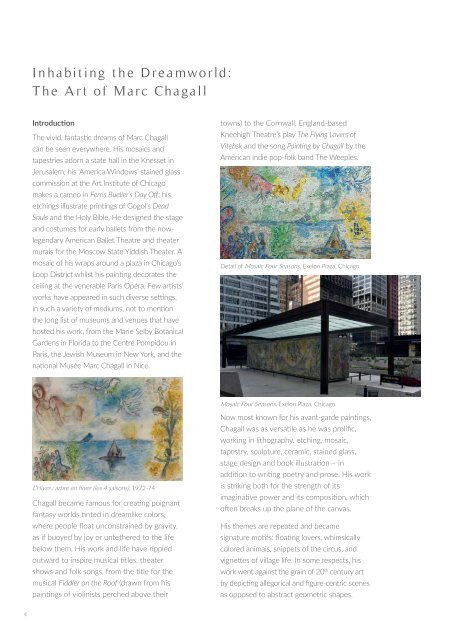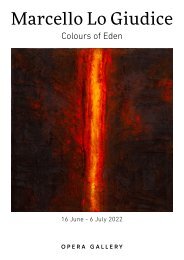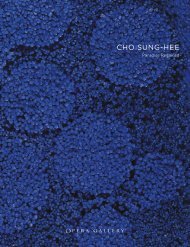Catalogue Chagall New York 2018
Create successful ePaper yourself
Turn your PDF publications into a flip-book with our unique Google optimized e-Paper software.
Inhabiting the Dreamworld:<br />
The Art of Marc <strong>Chagall</strong><br />
Introduction<br />
towns) to the Cornwall, England-based<br />
Filled with metaphor, his works recalled the<br />
Empire that confined Jewish settlement to<br />
The vivid, fantastic dreams of Marc <strong>Chagall</strong><br />
can be seen everywhere. His mosaics and<br />
tapestries adorn a state hall in the Knesset in<br />
Jerusalem; his ‘America Windows’ stained glass<br />
commission at the Art Institute of Chicago<br />
makes a cameo in Ferris Bueller’s Day Off; his<br />
etchings illustrate printings of Gogol’s Dead<br />
Souls and the Holy Bible. He designed the stage<br />
and costumes for early ballets from the nowlegendary<br />
American Ballet Theatre and theater<br />
murals for the Moscow State Yiddish Theater. A<br />
mosaic of his wraps around a plaza in Chicago’s<br />
Loop District whilst his painting decorates the<br />
ceiling at the venerable Paris Opéra. Few artists’<br />
works have appeared in such diverse settings,<br />
in such a variety of mediums, not to mention<br />
the long list of museums and venues that have<br />
hosted his work, from the Marie Selby Botanical<br />
Gardens in Florida to the Centre Pompidou in<br />
Paris, the Jewish Museum in <strong>New</strong> <strong>York</strong>, and the<br />
national Musée Marc <strong>Chagall</strong> in Nice.<br />
Kneehigh Theatre’s play The Flying Lovers of<br />
Vitebsk and the song Painting by <strong>Chagall</strong> by the<br />
American indie pop-folk band The Weepies.<br />
Detail of Mosaic Four Seasons, Exelon Plaza, Chicago<br />
Vitebsk of his boyhood, celebrated his<br />
romances and stood against world war<br />
horrors, communicating nostalgia, joy and<br />
darkness. Some critics found him difficult:<br />
having absorbed a variety of modern art<br />
trends early in his career, he borrowed from<br />
them without ever fully joining them. As the<br />
French art historian Pierre Schneider argues, “He<br />
used them only to suit his own aesthetic purposes.<br />
That makes it hard for art critics and historians<br />
to label him. He can’t be pigeonholed.”<br />
If his work is now ubiquitous to the point of<br />
familiarity, it was stunningly original then.<br />
Drawing from elements of folk art and the<br />
Russian icon tradition, <strong>Chagall</strong> created<br />
narratives in his compositions and infused them<br />
with wonder, juxtaposing humans and<br />
creatures while altering them to seem<br />
otherworldly. His choice to string together<br />
seemingly unrelated elements into a surreal<br />
mixture gives his paintings their ambiguity<br />
its western part and restricted the movement<br />
of Jewish people. His hometown was Vitebsk,<br />
in the northeast of what is now Belarus.<br />
“Vitebsk is a place like no other,” he wrote.<br />
“A strange town, an unhappy town, a boring<br />
town.” Despite this dismissal, Vitebsk followed<br />
him throughout his life: the village featured in<br />
many of his paintings, becoming a scrambled<br />
theme repeating in his work. Decades later,<br />
he would publish a letter to the city, writing<br />
“I did not live with you, but I didn’t have one<br />
single painting that didn’t breathe with your<br />
spirit and reflection.”<br />
<strong>Chagall</strong> began studying in an art school run by<br />
a local portraitist before maneuvering around<br />
the Czarist restrictions on Jewish resettlement<br />
to move to St. Petersburg and attend art<br />
school in 1906. For a time, he worked under<br />
artists famous for designing sets and costumes;<br />
he would be part of the theater world time<br />
and their power to evoke feeling, pioneering<br />
a method for telling dreamlike stories that<br />
Mosaic Four Seasons, Exelon Plaza, Chicago<br />
anticipated the rise of the Surrealist movement.<br />
Now most known for his avant-garde paintings,<br />
<strong>Chagall</strong> was as versatile as he was prolific,<br />
working in lithography, etching, mosaic,<br />
“I don’t know where he gets those images,”<br />
Pablo Picasso once said, “he must have an<br />
angel in his head.”<br />
L’Hiver : arbre en hiver (les 4 saisons), 1972-74<br />
<strong>Chagall</strong> became famous for creating poignant<br />
fantasy worlds tinted in dreamlike colors,<br />
where people float unconstrained by gravity,<br />
as if buoyed by joy or untethered to the life<br />
below them. His work and life have rippled<br />
outward to inspire musical titles, theater<br />
shows and folk songs, from the title for the<br />
musical Fiddler on the Roof (drawn from his<br />
paintings of violinists perched above their<br />
tapestry, sculpture, ceramic, stained glass,<br />
stage design and book illustration – in<br />
addition to writing poetry and prose. His work<br />
is striking both for the strength of its<br />
imaginative power and its composition, which<br />
often breaks up the plane of the canvas.<br />
His themes are repeated and became<br />
signature motifs: floating lovers, whimsically<br />
colored animals, snippets of the circus, and<br />
vignettes of village life. In some respects, his<br />
work went against the grain of 20 th century art<br />
by depicting allegorical and figure-centric scenes<br />
as opposed to abstract geometric shapes.<br />
<strong>Chagall</strong>’s life overlapped with the most politically<br />
tumultuous events of twentieth-century<br />
Europe, which steered the trajectory of his<br />
life and art. War, revolution, and persecution<br />
drove him for a time from the places that had<br />
meant the most to him. His hunger for<br />
the places he left echoes in his art,<br />
the melancholy of the exile haunted by<br />
the memory of lost homes.<br />
Early Life: Vitebsk<br />
Marc <strong>Chagall</strong> was born Moishe Zakharovich<br />
Shagal in 1887 into a Jewish family in a Russian<br />
Visions de Paris, 1953<br />
and again, and its rules would influence his art.<br />
In 1909, he met one Bella Rosenfeld, the<br />
accomplished daughter of a wealthy family<br />
studying to be an actress under Stanislavsky,<br />
to whom he would become engaged and who<br />
would be his most famous muse.<br />
4 5

















